Jumping.
Jumping, jumping, jumping.
It’s probably the last thing you think about when it comes to pure self-defense, but still an integral part of original Karate (jumps can be found in traditional kata across all styles, ranging from Okinawan styles such as Uechi-ryu, Isshin-ryu, Goju-ryu and Shorin-ryu to Japanese styles like Shotokan, Shito-ryu and Wado-ryu).
Admittingly, it’s not the most common technique we have in Karate – although old-school action heroes like Chuck Norris and Jean-Claude Van Damme seemed to imply otherwise in the many movies that shaped Western society’s view on Karate (and the Oriental martial arts in general) during the ‘golden 80’s’.
And let’s not forget Karate Kid, with the iconic crane kick!

So, even though jumps – with or without kicks – are not as commonplace in Karate as media portrays them to be, they do exist to some extent in various kata that we still practise – both in traditional and modern Karate.
And the harsh reality is this:
The quality of your jump is what will make or break your kata.
(Or you bones!)
No, but seriously though. Even, for example, when you see an athlete like Antonio Diaz performing his signature kata (Suparimpei), we’re all pretty much just waiting for the jump. Sure, the other techniques are impressive and all… but the jump is the icing on the cake.
How come?
Because that’s the way we humans function.
- We love spectacular stuff.
- We love seeing other people take risks.
- We love the feeling of not knowing if somebody will miserably fail or happily succeed right in front of our very own eyes.
And jumping is a huge risk.
One that people will automatically focus on… and judge you on.
So, what I’m going to do today is take you through my personal three-step guide to practially improving your jumping ability – by breaking down and quickly looking at the main components that make up the typical Karate jump.
(Kicks or not.)
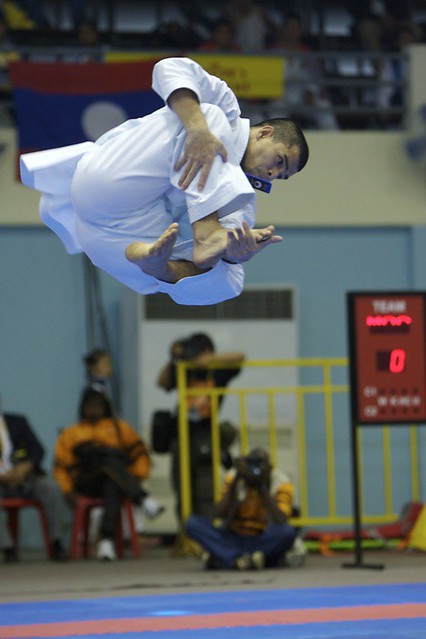
Now, of course, having a great jump first and foremost means having great muscles (along with the connectivity between those muscles and your brain). But if you lack the technique needed for optimizing and converting that strength, it doesn’t matter if you can front squat twice your bodyweight or not
You will still need proper technique.
The dictionary definition of jump is to spring off the ground by a muscular effort of the legs and feet. However, this definition is only partially correct, and maybe this is why most people only partially train jumping correctly. Great jumping requires coordinated movement of the arms, legs and feet – not to mention the core.
And in my opinion, here’s where most people fail.
So, with that being said, I’ll leave the strength/explosiveness training to you, and now just focus on helping you improve your jumping ability by looking at the concept and theory behind the actual technique of a perfect Karate jump.
Sounds good?
Awesome.
To make my points clearer, I’ve chosen to illustrate each step with a snapshot taken from the kata Kanku Dai, as performed by multiple-time world kata champion Luca Valdesi (here’s the original video, shot by me at the 11th Italian Open in 2010).
The jump starts from this position:
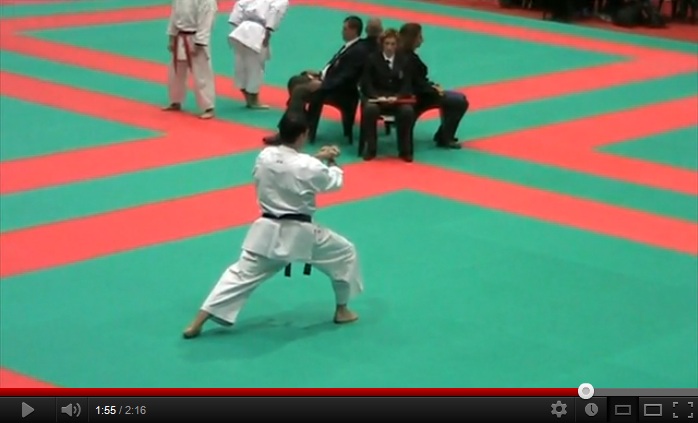
Let’s go:
Step #1: The Knee Lift
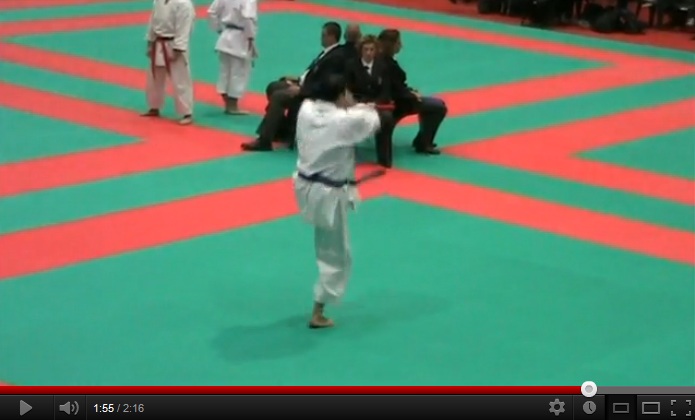
The first thing you will need, to really jump high, is a great knee lift.
As the saying goes, “every great journey starts with a single step” – well, this journey starts with a knee raise.
The key part of this phase is to swiftly lift your knee as high as possible, making sure you keep it in front of your body and not to the side. The leg should almost brush your other (supporting leg) as you lift it, thereby ensuring that your energy is directed straight upwards (where we want it to go).
To maximize the height of your jump, it is essential that you are flexible in your hamstrings and lower back, while at the same time forcefully activating your illopsoas (internal hip muscles) to such a degree that the lifting leg actually acts as a weight – literally pulling your body upwards.
And remember to use your arms!
The whole movement looks like a quick knee strike, done as high as possible in thin air.
Then, after having mastered the first stage, comes the second phase:
Step #2: The Kick Off
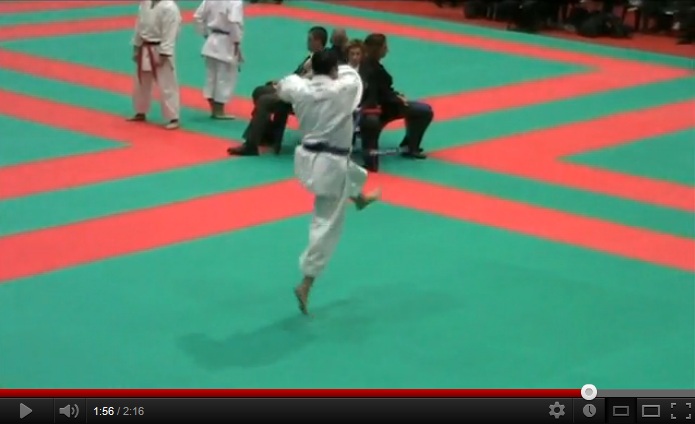
Here’s where you really need to show off those butt muscles I know you’re secretly pumping at the gym.
As soon as you’ve completed the knee lift, your supporting leg now strongly kicks off from the ground, initially riding on the momentum gained by the previous knee raise, then boosting it even more by pushing off with your whole posterior chain (hamstring, back, calves) to leave ground.
To avoid injuries, and to jump as high as possible, it is recommended that you keep your toes and knee pointing in the same direction (forward, but slightly outward is okay) so that your joints are naturally aligned for optimum efficiency and safety.
At this stage, the more forceful your kick against the ground is, the better your jump will be – so make sure you give it 120%.
The comes the trickiest part:
Step #3: The Pull Up
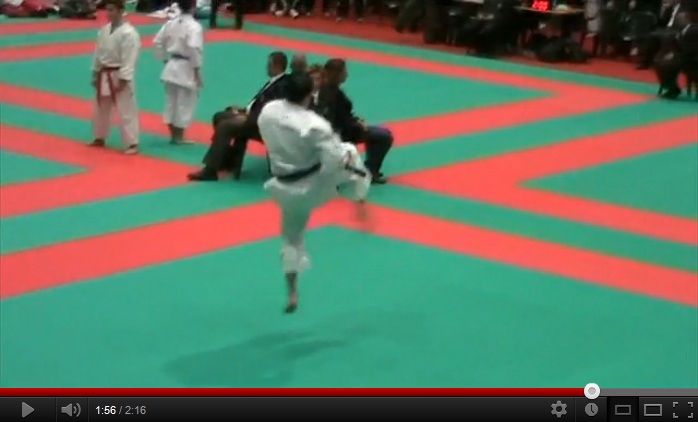
So, you’re soaring through the sky like an eagle, having completed phase 1 and 2 (knee lift and kick off), right?
Well, almost.
You see, the whole jump will now fail if you don’t complete phase three – which consists of immediately pulling up your supporting leg (the one you just kicked off with) as swiftly as possible, in the exact same manner as you lifted your first leg up with in step one.
Needless to say, this requires an insane amount of inner core muscle activity (and no, not the kind you get from doing two hundred crunches in front of the TV every night), since you don’t have the same support from the ground anymore.
And that completess the third, and last, step for achieving a high jump for Karate (you can then add a kick, a 180/360 spin whatever).
The thing most people never realize is that each one of these three steps require 100% commitment, energy and focus.
Both physical and mental.
It’s not “just a jump”.
(Well, unless you are Jackie Chan of course.)
So, if you feel you have a “bad” jump, I strongly advice you to tell a friend about these three basic steps, and then have them take a look at your jump to identify the phase you need to improve. In 9 times out of 10, they will quite easily spot the step where you lost some momentum.
Lastly, a few words on safe landings:
- Land on the ball of your foot and sink into your heel.
- Flex at the hips, knees and ankles.
- Maintain a straight back with neutral spine position.
- Maintain chest over knees and knees over toes.
Landings are more important than you think.
Research shows the typical male athlete lands with forces two and a half times his body weight after a maximum jump, while females land with forces up to five times their body weight.
This large ground-reaction force places great tension on the muscles, tendons, ligaments and cartilage surrounding the knee, which is why, as I said in the intro, it’s adviced you have a solid strength base for jumping techniques.
In other words; strength, along with proper technique (which we just went through), is what will ultimately make you jump like the Karate Kid you always wanted to be.
Right?
That’s what I thought.
So just focus, Daniel-san…
That’s all for today.
_____
(PS. Big congratulations (and thanks!) to Terry Soucy, New Brunswick, Canada, for his winning testimonial in my mini-competition last week! Just send me your address and the book will be in the mail! Thanks to everyone else who participated.)



12 Comments